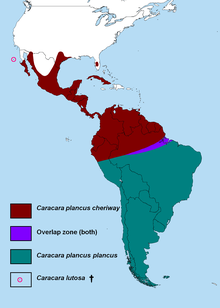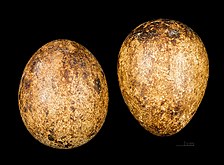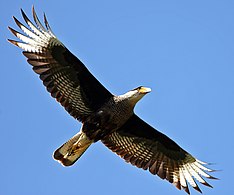Crested caracara
| Crested caracara | |
|---|---|

| |
| An adult crested caracara in Serra da Canastra National Park, Brazil | |
| Scientific classification | |
| Domain: | Eukaryota |
| Kingdom: | Animalia |
| Phylum: | Chordata |
| Class: | Aves |
| Order: | Falconiformes |
| Family: | Falconidae |
| Genus: | Caracara |
| Species: | C. plancus
|
| Binomial name | |
| Caracara plancus (Miller, JF, 1777)
| |

| |
| Synonyms | |
|
Polyborus plancus | |
The crested caracara (Caracara plancus), also known as the Mexican eagle,[3] is a bird of prey in the falcon family, Falconidae (formerly in the genus Polyborus). It is found from the southern and southeastern United States through Mexico (where it is present in every state) and Central and South America, as well as some Caribbean islands. Documented rare sightings have occurred as far north as northern Minnesota and as far south as Tierra del Fuego.
Taxonomy
In 1777, English illustrator
Two subspecies are recognised:[6]
- C. p. cheriway (Jacquin, 1784) – United States (Southern California,[7] Arizona, Florida, Louisiana, New Mexico, Texas),[8] México (present in every state),[9] Belize, El Salvador, Guatemala, Honduras, Nicaragua, Costa Rica, Panamá, Colombia, Venezuela, Ecuador, Guyana, Suriname, French Guinea, and north Roraima, Brazil;[10] Caribbean islands of Cuba, Aruba, Guanaja and Roatán (Honduras), and Trinidad; the Pacific Islas Marías (Mexico) and Isla del Rey (Panamá).[10] Individual birds have been seen as far north as Dallas, Texas and Santa Cruz, California.[11]
- C. p. plancus (Miller, JF, 1777) – SE Perú, N Bolivia to Eastern Brazil, south to Tierra del Fuego and the Falkland Islands.
The subspecies C. p. cheriway was formerly classed as a separate species, with the common English name of the northern crested caracara.[6][12]
Description
The crested caracara has a total length of 50–65 cm (20–26 in) and a wingspan of 120–132 cm (47–52 in). Its weight is 0.9–1.6 kg (2.0–3.5 lb), averaging 1,348 g (2.972 lb) in seven birds from
-
Eggs,MHNT
-
Juvenile
-
Young adult
-
Adult
Behavior
A bold, opportunistic
-
Young adult, showing the distinctive light 'windows' in the wings
-
Adult
-
Beingmobbed by a fork-tailed flycatcher
-
Young adult perched on a cactus,BES Islands
-
Northern crested caracara (Caracara plancus cheriway), Attwater Prairie Chicken National Wildlife Refuge, Colorado County, Texas, USA
-
An immature bird surveying the surroundings in Texas, USA
-
An adult in Panama Viejo, Panama foraging for food.
Distribution and habitat
The crested caracara occurs from
Reports have been made of the crested caracara as far north as San Francisco, California.[19] and, in 2012, near Crescent City, California.[20] Some are believed to possibly be living in Nova Scotia, with numerous sightings throughout the 2010s.[21] In July 2016 a northern caracara was reported and photographed by numerous people in the upper peninsula of Michigan, just outside of Munising.[22][23][24] In June 2017, a northern caracara was sighted far north in St. George, New Brunswick, Canada.[25] A specimen was photographed in Woodstock, Vermont in March 2020.[citation needed] The species has recently become more common in central and north Texas and is generally common in south Texas and south of the US border.[citation needed] It can also be found (nesting) in the Southern Caribbean (e.g. Aruba, Curaçao and Bonaire)[citation needed], Mexico, and Central America.
Florida caracara
Florida is home to a
Crested caracara in Mexico
Mexican
Texan eagle
Balduin Möllhausen, the German artist accompanying the 1853 railroad survey (led by Lt. Amiel Weeks Whipple) from the Canadian River to California along the 35th parallel, recounted observing what he called the "Texan Eagle", which, in his account, he identified as Audubon's Polyborus vulgaris. This sighting occurred in the Sans Bois Mountains in southeastern Oklahoma.[31]
Status
Throughout most of its range, its occurrence is common to very common. It is likely to benefit from the widespread
References
- . Retrieved 12 November 2021.
- ^ "NatureServe Explorer 2.0". explorer.natureserve.org. Retrieved 30 September 2022.
- ^ "Crested Caracara Overview, All About Birds, Cornell Lab of Ornithology". allaboutbirds.org. Retrieved 28 November 2023.
- .
- ISBN 978-1-4081-2501-4.
- ^ Rasmussen, Pamela, eds. (July 2023). "Seriemas, falcons". IOC World Bird List Version 13.2. International Ornithologists' Union. Retrieved 3 October 2023.
- ^ "Observations • iNaturalist". iNaturalist. Retrieved 2 April 2024.
{{cite web}}: CS1 maint: url-status (link) - ^ "Observations • iNaturalist". iNaturalist. Retrieved 2 April 2024.
{{cite web}}: CS1 maint: url-status (link) - ^ "Observations • iNaturalist". iNaturalist. Retrieved 2 April 2024.
{{cite web}}: CS1 maint: url-status (link) - ^ a b "Observations • iNaturalist". iNaturalist. Retrieved 2 April 2024.
{{cite web}}: CS1 maint: url-status (link) - ^ "Observations • iNaturalist". iNaturalist. Retrieved 2 April 2024.
{{cite web}}: CS1 maint: url-status (link) - .
- ^ Info about the southern caracara at Zootierliste.de
- ^ ISBN 978-1-4200-6444-5.
- ^ a b "Caracara cheriway (Crested caracara)". Animal Diversity Web.
- ^ "Crested Caracara | the Peregrine Fund".
- ^ a b c Ferguson-Lees, J. & Christie, D.A. & Franklin, K. & Mead, D. & Burton, P.. (2001). Raptors of the world. Helm Identification Guides.
- ISBN 978-0-395--70959-7.
- ^ "Rare Raptors". Golden Gate Raptor Observatory. Archived from the original on 3 October 2009. Retrieved 22 August 2009.
- ^ "caracara sighting record". Project Noah. 13 February 2012.
- ^ "What's this crested caracara doing in Nova Scotia? | CBC News". CBC. Retrieved 2021-01-14.
- ^ Scot, Stewart. "News". Nature Photography by Scot Stewart. Retrieved August 2, 2016.
- ^ Bernard, Daryl. "Crested Caracara". iNaturalist.org. Archived from the original on July 14, 2019. Retrieved August 2, 2016.
- ^ "Pictured Rocks National Lakeshore Instagram". Archived from the original on 2021-12-24. Retrieved August 2, 2016.
- ^ Corbett, Tanya. "News". CBC News. Retrieved June 28, 2017.
- ^ "Chapter VIII. Florida Relict Species". Resource Guide. Indian River Lagoon Envirothon. Retrieved 23 January 2009.[dead link]
- ^ "Audubon's Crested Caracara" (PDF). South Florida Ecological Services Office. United States Fish and Wildlife Service. Archived from the original (PDF) on 5 February 2021. Retrieved 23 January 2009.
- ^ Morrison, J.L. (October 2004). "The Crested Caracara in the changing grasslands of Florida" (PDF). In Noss, R. (ed.). Land of Fire and Water: The Florida Dry Prairie Ecosystem. Proceedings of the Florida Dry Prairie Conference, October 2004. Sebring, Florida. pp. 211–215.
- ^ "Species Profile: Crested Caracara". Florida Fish and Wildlife Conservation Commission. Retrieved 20 March 2024.
- ^ González Block, Miguel A. (2004). "El Iztaccuahtli y el Águila Mexicana: ¿Cuauhtli o Águila Real?". Arqueología Mexicana (in Spanish). XII (70): 60–65. Archived from the original on 2009-02-16.
- ^ Möllhausen, Balduin (1858). Diary of a Journey from the Mississippi to Coasts of the Pacific With a United States Government Expedition. Longman, Brown, Green, Longmans, & Roberts. p. 45.
Further reading
- Dove, C. & R. Banks. 1999. A Taxonomic study of Crested Caracaras (Falconidae). Wilson Bull. 111(3): 330–339. Available online (PDF) Archived 2012-03-02 at the Wayback Machine
- Ferguson-Lees, J., D. Christie, P. Burton, K. Franklin & D. Mead (2001). Raptors of the World. Christopher Helm. ISBN 0-7136-8026-1
- Restall, R., C. Rodner, & M. Lentino (2006). Birds of Northern South America. Vol. 1 & 2. Helm, London. ISBN 0-7136-7243-9(vol. 2)
- Schulenberg, T., D. Stotz, D. Lane, J. O'Neill, & T. Parker III (2007). Birds of Peru. Helm, London. ISBN 978-0-7136-8673-9
External links
- Photos and text – arthurgrosset.com
- Photos and text – faunaparaguay.com














